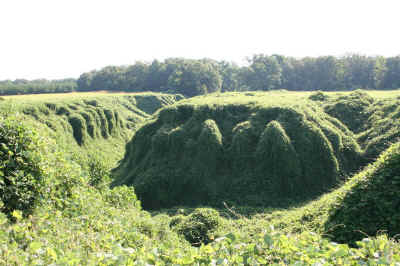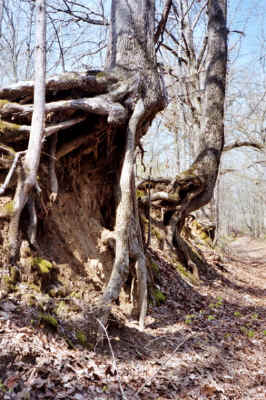| Kudzu |
Don
Bragg |
| Aug
21, 2006 06:12 PDT |
ENTS--
As we headed towards Village Creek State Park, Arkansas we
stopped
along the highway to view a gully that had formed following poor
agricultural
practices on the top of the ridge. One of the unique features
about the
silty soils of loess is how they erode--they can erode easily,
but they
can also retain their vertical integrity well (hence, their use
for
excavated shelters during the Civil War). The gully we observed
had
very steep (virtually vertical) walls perhaps 50 or more feet
deep.
The gully had a weird green color to it because it was covered
in
another enigma of the South--kudzu. This is actually an example
of
exactly why kudzu was introduced to the South--it excels at
covering and
stabilizing eroding soils. This gully has probably not changed
markedly in many years to perhaps decades because of its kudzu
covering.
Unfortunately, kudzu doesn't know that it was supposed to stay
only in
the eroding areas, and now large blankets of kudzu cover many
areas. I
will send Ed a picture of this gully (which reminds me in some
ways of
the canyons I saw out west).
Don Bragg

Kudzo covered gully - photo by Don Bragg |

Kudzu Covered Gully- photo by Randy Brown
"a spectacular kudzu shrouded ravine that snakes
out
of the State park and stops just short of the road"
|
Ed,
Saw your request for "Kudzu covered gullies". I
did get a good
picture during the spring Ents Arkansas trip, I stopped at
Village
Creek State Park (on the Crowely's ridge region), which
apparently
has a lot of loess. The first picture is a spectacular
kudzu
shrouded ravine that snakes out of the State park and stops just
short of the road.
Randy Brown
|
| RE:
Loess hills |
Don
Bragg |
| Aug
22, 2006 05:37 PDT |
Randy,
I got the distinct impression that a lot of people stop to
gawk at that
gully--we ended up parking in what looked to be a parking
spot worn
onto the shoulder--probably by the local soil
conservationist taking
people there to tell them tales of loess, erosion, and
kudzu.
We did not get out and explore much of that spot--we had a
day full of
stops planned, and this was just pit stop...
Don Bragg
--
Randy Brown wrote:
| |
Don,
Heh. I ended up in the same place on the way back
and probably took
pictures of the same gully. I
imagine seeing all the out of
staters stop and gawk provides some hilarity to the
locals.

A very old road-bed that dates from early
1800's and
was reportedly on route on the infamous Trail of
Tears (1838). You
can see how deeply incised it is in the deep
loess (perhaps 10'
here) on the steep slopes and the trees that have
been undermined by
the erosion.
Anyway did you hike the old Roadbed and see the
tree's standing on
stilt roots from the erosion?
Rand
|
|
| King
Kudzu |
Robert
Leverett |
| Aug
21, 2006 07:36 PDT |
Don,
Your kudzu story reminded me of the use made
of that pesky vine by
highway engineers in the mountains of eastern Tennessee, western
North
Carolina, and northern georgia when I was growing up there. They
all
thought the answer to their prayers had come in the form of
kudzu since
it grew so quickly and covered slide-prone banks. I can attest
that the
stuff grows so fast that you could almost hear it growing. In
the
summer, it can grow a foot a day. However, the highway engineers
were
soon singing a different tune, thinking less about kudzu as a
blessing
from the Diety and more about kudzu as a satanic curse. But by
then it
was too late. In my youth I watched kudzu cover tuliptrees at
100 to 120
feet tall. The trees were cut off from light and killed. There
are some
remarkable pictures of kudzu at http://www.yahoolavista.com/kudzu/.
Interestingly, despite its bad
reputation, kudzu has many practical
uses. It is nutritious for humans and animals alike. It has been
used in
Chinese and Japanese herbal medicines for centuries.
Craftspersons make
baskets from kudzu vines. There are even books out on how to
cook using
kudzu. Heck, maybe it is the modern manna from Heaven and we
just
haven't come to realize it yet. Maybe we should all be out there
furiously planting kudzu, staring lovingly at it as it covers
our trees,
cars, garages, and houses.
I'll bet our good friend Will Fell could
tell us some pretty
entertaining stories about kudzu. Will, got any kudzu tales that
you'd
be willing to share? Have any towns disappeared under kudzu in
southern
Georgia?
Bob
|
| RE:
King Kudzu |
Edward
Frank |
| Aug
21, 2006 19:15 PDT |
| Re:
King Kudzu |
Michele
Wilson |
| Aug
21, 2006 19:44 PDT |
An interesting trip through Kudzu Land. A colleague headed
to Florida back
around 1990 and soon after told me of the existence of kudzu
vines. Glad
they're not around here! It seems we do need to be thinking
about
stiltgrass around here, however.
Michele
|
| Kudzu
of the north |
Steve
Galehouse |
| Aug
21, 2006 20:23 PDT |
We have no Kudzu here in NE Ohio; instead we have Hall's
Japanese
honeysuckle, which can become so established and entrenched
in the woods
that it's growth resembles the Kudzu of the southern states.
If it
would only smother the garlic mustard and glossy buckthorn,
and leave
the natives alone, then it would be OK.
Steve |
| RE:
King Kudzu |
Willard
Fell |
| Aug
22, 2006 06:36 PDT |
Actually Kudzu is not that big of a problem in the flatwoods
of SE
Georgia. It was widely planted for erosion control in the
hillier
piedmont region of the southeast and many of the photos on
the website
were taken in those regions. When I was in school up at
Athens there was
a large wooden warehouse on the edge of campus known as the
guano barn.
This old fertilizer warehouse was as large as a basketball
gymnasium and
was completely covered by kudzu so as to appear to be a
large green hill
by the side of the road. It was not uncommon to see it
spread across RR
tracks that were infrequently used.
Down here Chinese Wisteria, Japanese Climbing Fern and
Japanese
Honeysuckle along with Japanese Privet, Chinaberry and
Tallow tree are
the big invasives. Others include Russian Olive, various
non-native
timber bamboos and Lespedeza. Don't know why so many of the
invasives
such as Kudzu are of Asian origin. Unfortunately all except
maybe Tallow
Tree were purposely introduced and widely planted as
ornamentals or
wildlife enhancements in years past only to come back and
haunt us. |
|